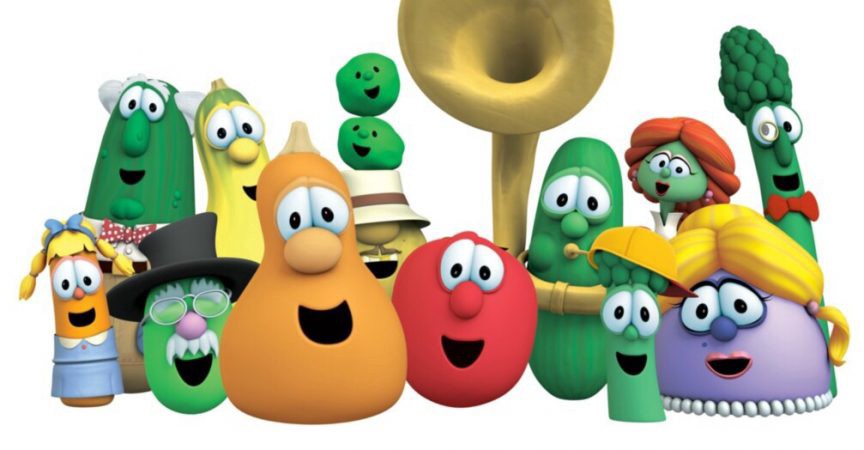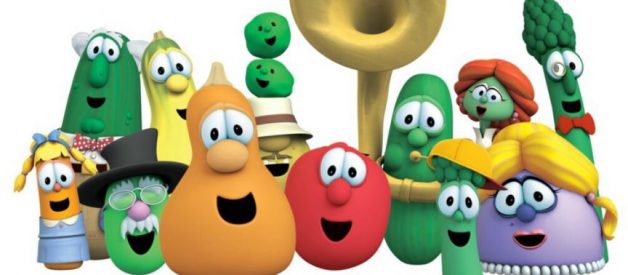 Veggie Tales cast of characters
Veggie Tales cast of characters
There was a recent study by a student at California State University San Marcos linking ?The Veggie Tales? Christian animated series and movies to racism. The claim is that the characters portrayed as villains often have accents that indicate a minority race, which influences children to develop a negative perception of minorities. There was also mention of these villainous characters having other racial indicators that would link them to minorities.
First of all, I am a mother of two young children and am intimately familiar with the Veggie Tales series in both television and movie form.
For those of you who haven?t had the dubious privilege of hours of exposure to most current cartoons, let me say that I can sing many of their songs word-for-word and can name most of the characters. Each character is a vegetable, as the name of the series suggests. Bob the Tomato and Larry the Cucumber are the stars of the show, although Junior Asparagus often steals the spotlight with arguably the world?s cutest animated voice.
Secondly, I should probably add that I am the child of a minister, and I would be the first person to say that all religious programming bears scrutiny.
In fact, I would go a step further and say that it?s important that we scrutinize any program or organization that represents itself as a moral authority. After all, religious and spiritual organizations are run by humans as infallible as the rest of us and subject to a personal value system that may be in direct opposition to spiritual teachings. Also, spiritual and religious teachings may be inherently flawed. All of that is open to debate, but we shouldn?t be afraid to take a closer look and examine if a religious program could be inadvertently promoting racism.
When I first heard of this study, my initial reaction was to be shocked that I hadn?t considered the racial implications of cartoon villains having an accent to indicate minority status. I blame my white privilege for taking so long to realize what minorities everywhere have known for decades. As I reflected on my many hours in front of this particular program, I could admit that the student positing this theory had a point.
After reading more, I began to greet the argument with a little more skepticism.
I?m not sure which shows or movies this student sat down and watched in particular to formulate this idea, but I?m going to hazard a guess that she?s unlikely to have watched as many hours of programming as I have, as it?s unlikely- though not impossible- that she?s spent years parenting small children. If I didn?t have children, I certainly would not voluntarily log so many hours in front of often-inane children?s cartoons.
There?s one hole in her particular theory. First of all, I would argue that there aren?t vegetables that appear darker than other vegetables to denote persons of color. The vegetables are portrayed as the color of vegetable they are drawn: Bob is a red tomato; Larry is a green cucumber; the French peas are green. While many of the characters have accents, this is common throughout most cartoons when those who vocalize multiple characters are trying to differentiate between them.
I would actually say that it?s more of a case of lazy storytelling (and vocalization) than outright racism- not just in Veggie Tales but in animation across the board. There?s this idea that children can?t understand more subtle villains, so the villainy of the characters must be exhibited with outrageous accents, over-the-top costumes, and other indicators of being the bad guy. Oftentimes, an accent is chosen that could arguably depict a minority, and while this can encourage racist attitudes, it?s also most certainly unoriginal and lazy storytelling.
Children don?t need a flamboyant accent of some kind to figure out who?s making good choices and who is making poor ones. Kids are so much smarter than many seem to realize. They?re capable of following a plot and telling you who was considered the hero or the villain of the story simply by paying attention to plot points. The other details- the accent, the manner of dress- are extraneous.
To take a closer look at Veggie Tales, in particular, the un-named student of this study may not realize that each character portrays a villain at some point or another. None of the characters are villains 100% of the time. Like many animated series, the characters form a cast like any other with stories told to illustrate different lessons and morals. Sometimes, the one needing to learn the lesson is Bob, Larry, or Junior- who often play the hero in other stories. The French Peas, who have French accents, were listed as villains portrayed as foreigners, but I can?t personally recall a single episode where the Peas were villains. They are usually perfectly adorable characters who take part in telling some type of story with a moral.
I do think that it?s a fair criticism to examine if the accents in Veggie Tales portray minorities in an unflattering light. I think we should examine all of the media that our children are exposed to in order to see what our kids are learning. For instance, in my household, my children never watch Cartoon Network- not one single show on it. I?ve had the distinct displeasure of watching Cartoon Network, and many of the characters portray awful characteristics as if they are positive ways to behave. It?s like trashy reality television for kids where the protagonists are awful examples of humanity. They?re rude, lazy, disrespectful, and often mean. I?m taking a hard pass on that as an example to my children.
I think if we examine more innocuous television shows, we sometimes see the same thing.
I hate Clifford the Big Red Dog- the television show, not the books- because I?ve found that my children have picked up on and emulated bullying behaviors and other poor choices directly from seeing it played out in a beloved children?s show or story read at school. My child didn?t know how to taunt other children until she saw it on television and heard about it in stories. I think we really need to ask ourselves how we can better address these topics in a way that doesn?t teach our children to adopt them.
I could list a multitude of shows that don?t portray the villains with accents indicating minority status. These shows also seem to be able to teach lessons in good values without teaching children to adopt poor choices. Paw Patrol and Bubble Guppies spring to mind, but those aren?t the only ones out there who manage to avoid lazy storytelling and yet still engage children. Little Einsteins, Netflix?s Luna Petunia, and the Muppet Babies reboot all manage to do what Veggie Tales does without resorting to accents to give their characters life.
Perhaps criticizing the show for lazy storytelling might be a fair critique, and we should certainly evaluate all children?s programming for factors that might encourage racism to develop.
After all, racism is learned. Children aren?t born hating other children for the color of their skin. They learn it somewhere. They often learn it from their homes, sometimes in ways their parents don?t even understand since not all racists are self-aware.
My daughter once picked up a peach crayon and called it ?skin color,? likely because at school the teachers encouraged her to complete drawings by also giving a tone to her skin, choosing the one that most closely matched her complexion. When she used that expression, I cringed, but then I talked about how people have different skin colors. Hers is darker than mine and closer to her dad?s olive tones. My son?s skin color is lighter than hers, a ginger trait. She could identify that some of her friends have brown skin, and she doesn?t see why people call some people ?black? because that?s not the crayon color of their skin. She can differentiate between shades and thinks nothing of it, but we talked about how the color peach might be the closest crayon shade to her skin color, but we shouldn?t call it ?skin color? because not everyone is the same color.
Some might say that?s a lot of detail for a 5-year-old, but she had no problem understanding it. Just like she has no problem understanding who the villain is based on behavior and not accents. She, like so many children her age, is so much smarter than some entertainment creators realize, and she picks up on the subtle messages in stories.
This is why I think it?s important that we are able to have a dialogue about messages in cartoons or children?s books without objections because the target of the inquiry is something beloved to us.
This same scrutiny can be applied to Baby, It?s Cold Outside and other holiday tunes igniting a controversy this holiday season.
When we take a closer look at entertainment we?ve normalized, we can often detect hints of racism and misogyny that should certainly be scrutinized and discussed. It doesn?t mean we have to head out to Hobby Lobby and stock up on tiki torches to burn some books or DVDs. It does mean that when we see these hints, we should be having an open dialogue within our homes about the cultural context and greater implications of what we?re listening to or viewing.
We shouldn?t be afraid to take a closer look at our entertainment any more than we should our belief systems.
Knowledge is definitely power, and we need to empower ourselves to be informed. People who are in the majority race and religion need to pay attention in particular because the majority doesn?t get to choose what is offensive to the minority. We don?t get to say what appropriates a culture or what character vocalizations make minorities appear to be less intelligent or have poor values. We need to listen if we don?t want to be the ones teaching the next generation the bigotry that we see in our own.
To paraphrase Maya Angelou, when we know better, we can do better. Perhaps Veggie Tales had no intention of making some villains appear to be minorities. Maybe their intentions were good, and their vocal stylings were just limited to the accents they could manage to differentiate the characters. But we shouldn?t get angry that the animated series is being scrutinized. We can disagree with the idea that it?s racist, but we should at least be willing to examine it with a critical eye before coming to that conclusion ? as we should examine anything that purports to represent a moral authority.


